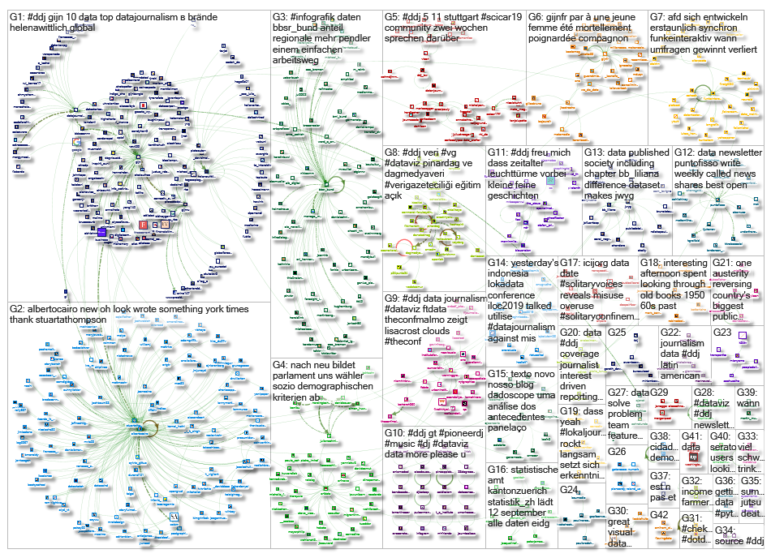What’s the global data journalism community tweeting about this week? Our NodeXL #ddj mapping from August 26 to Sept 1 finds The New York Times examining the massive amount of digital trackers that follow an individual’s web activity, The Washington Post looking at the stress on global water resources, Data Visualization Society announcing the first #VizRisk challenge winners, and Datajournalism.com sharing tips on how journalists can learn to code.
Zero Web Privacy
Farhad Manjoo, opinion columnist for The New York Times, agreed to have his digital activity tracked and examined for journalism. His internet activity and corresponding digital trackers he gathered were visualized by data visualization designer Nadieh Bremer. “The big story is as you’d expect,” concluded Manjoo, “that everything you do online is logged in obscene detail, that you have no privacy.”
One day of browsing. 47 sites. Hundreds of trackers. Excellent visualization of the web tracking everyday users experience on a daily basis.https://t.co/4zTY0WZcoN pic.twitter.com/7Bq0iyJpgl
— Steven Englehardt (@s_englehardt) August 23, 2019
Visualizing Risk
The first-ever VizRisk Challenge asked data visualization professionals, designers, developers, and researchers how we could use maps and data viz techniques to more creatively and effectively communicate the risk of natural hazards and disasters. Briane Paul V. Samson and Unisse C. Chua won the grand prize for their piece focused on Marikina City in the Philippines. Read their story here and check out the other winners here.
Congratulations to the 2019 #VizRisk winners! These maps really show off the value of data visualization used for understanding and addressing risk. We're so proud to have collaborated with @Mapbox, @UnderstandRisk & @WorldBank on this important topic!https://t.co/hcyC5IhTkr
— Data Visualization Society (@DataVizSociety) August 23, 2019
Mapping Stress on Water Resources
The World Resources Institute’s Aqueduct Water Risk Atlas draws from 50 years of data to estimate the typical water supply of 189 countries compared to their demand. Researchers used hydrological models to calculate the scale of “water stress” — how close a country comes to draining its annual water stores in a typical year. The Washington Post took a closer look at the water stress in some of the most precarious countries and several states in the United States.
Water strain is becoming a big problem in some places you'd expect: California, New Mexico, Arizona… but also some you may not have in mind, like Nebraska, Colorado, New Jersey or Wyoming.
By @bonnieberkowitz and @AdrianBlancoR https://t.co/CwCpytiYwT— Chiqui Esteban (pronounced 'Cheeky') (@chiquiesteban) August 6, 2019
Hurricane Cone of Uncertainty
Cones are commonly used to visualize forecasts of the potential path of hurricanes. They look deceptively simple but they have some nuances that many people do not understand. Data visualization expert Alberto Cairo explains just how people misinterpret these hurricane maps.
This is a marvelous piece of explanatory journalism https://t.co/G4Co3z89nL
— Michael Roston (@michaelroston) August 29, 2019
Learn to Code Like a Journalist
Coding has become an essential skill for newsroom journalists. So how can you get started? Datajournalism.com gathered practical advice from a group of global experts in their Conversations with Data newsletter. They are also always on the look out for data longform write-ups. Pitch details here.
Coding has become an essential skill for newsroom journalists, but many of us are still hesitant to get started.
To help, we pulled together a group of #ddj experts for their top tips on learning to code (like a journalist!)
👇👇https://t.co/G6SIhTFSYK #coding #datajournalism pic.twitter.com/WOFvHqZ9dd— DataJournalism.com (@datajournalism) August 30, 2019
Search Engine for Charts
A team of former journalists, engineers, consultants, and researchers built Grafiti — a search engine for charts, graphs, infographics, and soon datasets. The platform indexes the best data-driven insights from credible publications, organizations, businesses, and its community of users.
Interesting: Grafiti is a (new) search engine for charts, graphs, infographics, and (soon) data sets. https://t.co/uNVRo5tUfO
It’s keyword/search success rate is a bit hit or miss but might be worth a look. pic.twitter.com/kIaPbHX911
— David Bisset (@dimensionmedia) August 27, 2019
Russia’s Judiciary
Who is eligible to be appointed as a judge in Russia, and can they be considered independent? Proekt Media took a deep dive into the history of Russia’s selection of judges. The newsroom analyzed how the education and previous work experiences of the members of the court influence their decisions.
Судьями в основном становятся бывшие клерки суда (43%) и силовики (34%). Адвокатов всего 4%. https://t.co/UIHH4Q2oNC
— Проект (@wwwproektmedia) August 28, 2019
Spousal Homicide
France’s Libération newspaper maintains a database of women killed by their spouses, husbands or ex-husbands. The data, collected from January 2017, lists the women’s first names, their stories, and the collateral victims. Every year, more than 100 women are killed. (In French.)
L’excellent et utile travail par @libe de mettre des noms et des histoires derrière des chiffres …
Meurtres conjugaux, des vies derrière les chiffres via @libe #GrenelleViolencesConjugales https://t.co/mDbSdJZZTt— Anaïs Martinez (@Naismtz7) September 3, 2019
“Data Essay” versus “Data Story”
Fullstack developer and information designer Eric William Lin tweeted his preference for using the term “data essay” rather than “data story” to refer to data visualization-driven pieces. Other visual designers chimed in with their thoughts on Twitter.
I use data documentary for that same reason.
— Kim Rees (they/she) (@krees) August 24, 2019
The Journalism of Things
Journalism meets the Internet of Things. The first Journalism of Things Conference will be held on November 5, 2019 in Stuttgart, Germany. The event intends to promote journalistic experiments using sensors and devices, as well as figure out how the technology and the data gleaned from it can be used for journalism. More information here. (In German.)
Das Programm unserer kleinen, feinen Journalism-of-Things-Konferenz ist jetzt online: Mit @Remrow @JanGeorgPlavec @plateauton @themaastrix @WLoosen: https://t.co/9RFEmGST9L #jotcon19 pic.twitter.com/G2p1Ua74Jj
— Jakob Vicari (@vicari) August 27, 2019
Thanks, once again, to Marc Smith of Connected Action for gathering the links and graphing them. The Top Ten #ddj list is curated weekly.
 Eunice Au is GIJN’s program coordinator. Previously, she was a Malaysia correspondent for Singapore’s The Straits Times, and a journalist at the New Straits Times. She has also written for The Sun, Malaysian Today and Madam Chair.
Eunice Au is GIJN’s program coordinator. Previously, she was a Malaysia correspondent for Singapore’s The Straits Times, and a journalist at the New Straits Times. She has also written for The Sun, Malaysian Today and Madam Chair.

